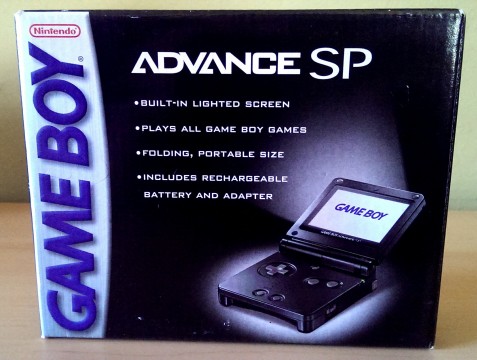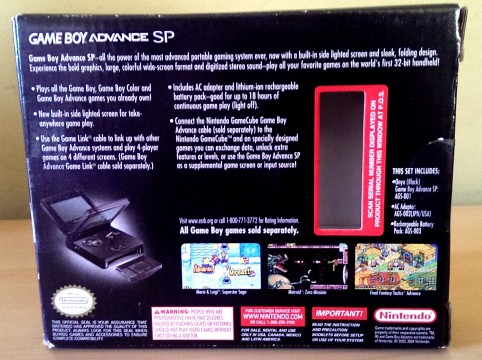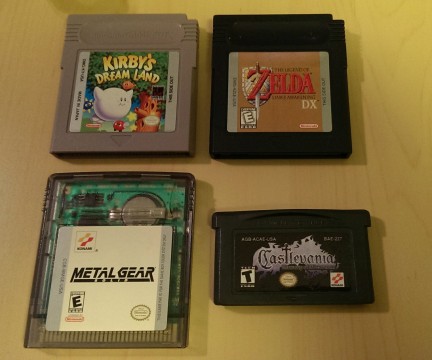
Game Boy Advance SP

Released: 2003
Game Boy Advance was doing well, but Nintendo had quickly gone back to the drawing board to craft a redesign of the unit. It was time to face facts; Game Boy needed to grow up. In what would become the most iconic model of the entire line, Nintendo unveiled Game Boy Advance SP in 2003, two years after GBA’s launch. SP was nearly pitch perfect; a clamshell design made Game Boy more compact than ever, and gave it a very sophisticated look. Once opened, players found that the control orientation was returned to the familiar vertical formatting of Game Boy’s past. The system also brought along a much-sought after light, with the first batches of SPs using a front-lit light, while later models delivered a backlit light and brightness adjuster. Pulling out all the stops, Nintendo went a step further and incorporated a rechargeable battery, too!
If there were any negatives to SP, it was a reduction in size of the L and R shoulder buttons and the removal of a dedicated headphone jack. For some reason (perhaps to sell Nintendo-made headphones?), SP had a special external jack that could only support special headphones. These headphones often came with a variety of Game Boy accessory kits, but it did little to ease the frustrations of fans who had an otherwise excellent new system. It was an odd misstep, but ultimately did little to stem the onslaught of sales that SP sparked. It remains one of the milestones of Nintendo hardware development.
Fun Facts
- Special editions became more prolific than ever during the lifespan of SP. An entire range of limited editions were released in Pokémon Centers and at Nintendo World (including Charizard, Groudon, Torchic, and more). Other variants included NES, Kingdom Hearts, Target, and Spongebob, among many, many more.
- Nintendo released a special device for Game Boy Advance called the e-Reader. Once plugged into a GBA, players slid special cards (sold in packs, like Pokémon or baseball cards) through the e-Reader that added content to games and offered minigames to play. A variety of e-Reader card packs were sold, including ones for Super Mario Advance 4 and Animal Crossing. Some Pokémon TCG cards were e-Reader compatible, as well.



Game Boy Micro

Released: 2005
Here it is, the final model of Game Boy to ever grace the world before the entire line went into permanent (for now, at least) hibernation. Game Boy Micro launched in 2005, a year after Nintendo DS had hit store shelves. The intent behind Micro was somewhat dubious; Nintendo had initially lauded DS as a “third pillar” of its hardware model, so it’s possible Micro was intended to carry on the Game Boy line until the supposed-next successor arrived. In any event, it was met with mixed reactions by fans and never got much of a footing in the market.
Living up to its name, Micro was the smallest Game Boy ever made. Not much smaller than an NES Control pad, Micro came with a backlit screen and was very sleek and stylish. Style was a part of the handheld’s marketing, actually, as its initial advertising made a point of illustrating the device’s swappable faceplates. Unfortunately, part of the cost of Micro’s minute size was a loss of backwards compatibility with Game Boy and Game Boy Color games. Throw in its diminished screen size (which some people complained made the text in certain games unreadable), and Micro was polarizing, at best. After a raucous lifetime, Game Boy went out on a quiet note with Micro.
Fun Facts
- Game Boy Micro managed to squeak out a number of special editions in its small heyday, but the arguably most beloved was the Special 20th Anniversary Edition, which was colored to match the look of Famicom (the Japanese version of NES), followed closely by a vivid red Mother 3 variant.
- Speaking of the Famicom version, in Japan, Club Nintendo members had the opportunity to snag an incredibly limited edition “Player II” faceplate for their Micros. It even had a fake microphone (a feature from the second player Control Pad on Famicom) printed on to make it more accurate. The faceplate is highly desirable amongst collectors (this writer included!).


The Cartridges

Though not as flashy as system redesigns and special editions, Game Boy’s cartridges evolved quite a bit over the years. The original cartridges were gray squares with a small notch taken out of the upper righthand corner. The notch was intended to keep the games from accidentally falling out of the system itself. The original Game Boy actually had a tab that would come out of the system when the power was turned on and rested snuggly inside of that notch, effectively “locking” the game in.
Game Boy Pocket eventually removed the safety tab, and Game Boy Color never had the feature at all. In fact, once Game Boy Color hit the scene, the cartridge was almost completely redesigned. The casing became a clear, smoky color, with a protruding oval-shaped bubble poking out of the top, replacing the indented oval from the old, gray cartridges. Also, no more notch in the corner. However, there was a second redesign in the form of special, black cartridges that could work on both a Game Boy and Game Boy Color. These black cartridges maintained the notch in the corner (so that original Game Boys could still play the games), and would display color graphics on Game Boy Colors, and monochrome graphics on Game Boy.
There were quite a few titles that came in the black cartridges, one of the most notable being The Legend of Zelda: Link’s Awakening DX. This version of Link’s Awakening contained a special color dungeon only available to players using a Game Boy Color (the game could actually recognize which type of Game Boy it was plugged into). Link’s Awakening DX could be played on both systems, but it was irresistibly cool knowing something special would happen playing on Game Boy Color. In a way, it was a clever marketing ploy on Nintendo’s part; it let players with the original Game Boy still get in on the action, but the unique features only available on Game Boy Color made them want to make the switch.
Once Game Boy Advance hit, the cartridges were essentially sliced in half, but maintained the black plastic and added a sort of raised lip at the top. Though Game Boy Advance and Game Boy Advance SP were backwards compatible, the old Game Boy and Game Boy Color cartridges stuck out partially, which was functional enough, though a little clumsy feeling. To people of the day, though, Game Boy Advance’s sleek cartridges were a sight to behold; it felt very bleeding edge to see such tiny video games in the palm of one’s hand! We’ve talked quite a bit about the differences between all these cartridges, but there’s something that every generation of Game Boy actually had in common: specially shaped cartridges!

Developers would sometimes come up with games or concepts that went beyond the limitations of whichever Game Boy hardware they were working on. In order to work around this, special game cartridges were occasionally made for particular titles. Rare’s Perfect Dark on Game Boy Color, for example, needed additional memory, and thus required a larger cartridge. Attached to it was a miniature Rumble Pak that was situated at the top and ran off of a single AAA battery! Game Boy Advance was no stranger to unique cartridges, either; Drill Dozer also sported a tall cartridge with a built-in Rumble Pak, and Yoshi Topsy Turvy had a gyro sensor! There are numerous cartridges like these, and were a special part of Game Boy’s history.
With that, you have the evolution of Game Boy! Any particular Game Boy you were fond of? Thoughts on the system, in general? Sound off in the comments!
Pages: 1 2




 ShareThis
ShareThis







My two fondest memories was playing Mario Land 2 on my Green, Play it Loud Game Boy, and playing the GBASP months before others in California because I imported it. I was the envy of many a Game Boy gamer back then.
It’s amazing to see how far we’ve come. I remember decking my GBA out with every accessory under the sun: screen cover with built in light, rechargeable battery, faceplate with thumbstick, and even a SD card media player. Now they’re all obsolete.
I had my Green Game Boy rocking the Handy Boy accessory with a rechargeable battery pack that allowed the almost portable Game Boy to become a Sega Nomad style cinder block.